Potatoes are most gardener’s favorite crop when it comes to growing them in a raised garden bed. They are easy to grow crops and produce great yields. If you aim to grow potatoes in a raised bed and need to know how to space them, this guide is surely for you.
A potato plant generally requires a spacing of 12 inches around it to flourish in a raised bed. When they are grown in rows, they should be spaced 12 to 15 inches apart and the rows 3 feet apart. The larger potatoes will require more space compared to the smaller ones.
This article will discuss how far we should space potato seeds in a raised bed. It will also discuss everything you need to know about growing potatoes in raised beds. So, keep reading.
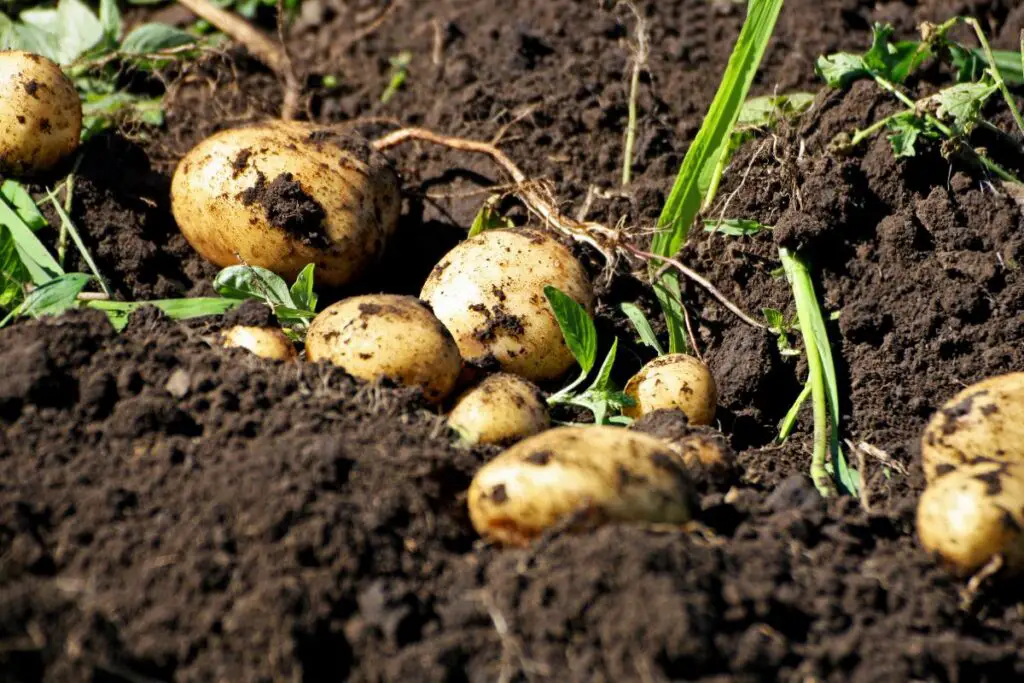
Why is it crucial to create space for potato plants?
Potatoes are easy to grow but need some planning.
If you provide your potato plants with proper spacing, you will get plenty of tubers in less time.
Potatoes grow differently than other underground tubers and need more space to thrive.
They will become deformed, discolored, stunted, or leggy if they don’t get sufficient room to grow.
In a small space, they will not be able to reach their full growth potential, and only a few potatoes will grow.
To ensure a successful harvest, you should have the following.
- Rich, well-drained, well-aerated soil.
- Organic, disease-free potato seeds that are already sprouted.
- Correct spacing measurements.
What will happen if you closely space the potato in a raised bed?
If you grow potato seeds very closely in a raised bed, you will not be able to hill them.
During the hilling process, potato plants are mounded with soil right above the ground.
Hilling is important to protect the potatoes from harsh direct sunlight, rain, or sudden temperature fluctuations.
Also, when too many potato plants grow together in one place, they will start competing for water and soil nutrients.
You might get small potatoes if the roots of your potato plant get obstruction under the soil.
The obstruction will occur if there is debris, rocks, sticks, etc., in the raised garden bed.
Other plants, including weeds, can compete with potato plants for resources and will restrict their growth.
Some taller plants like corn, beans, and tomatoes can shade the potato plants.
As a result, the potato plants will not get the required sunlight for carrying out physiological processes.
When plants are overcrowded, the air circulation around them reduces.
Due to lack of air, the leaves will remain moist for longer, which causes various fungal diseases in the plant.
For these reasons, it is necessary to correctly space potato plants.
How do you space potatoes in a raised garden bed?
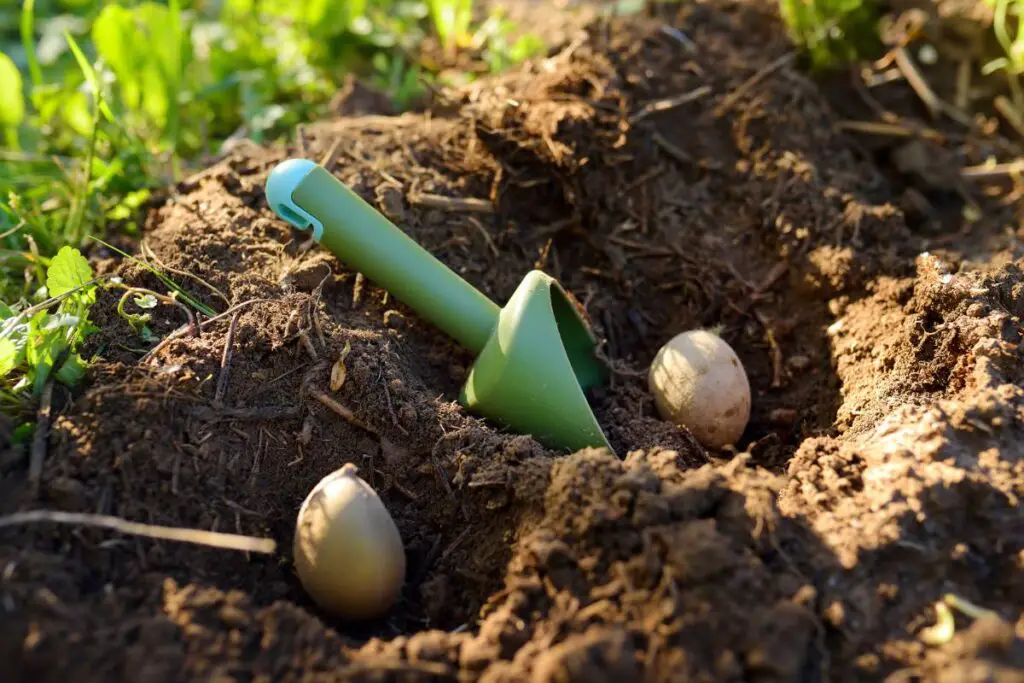
Potato spacing depends on the variety of the potato you want to grow and the size of your raised garden bed.
Potato tubers need plenty of space under the soil to form and mature, so it’s important to space them further apart so that all the plants will have equal rooms to grow.
The larger varieties of potatoes usually require more space than the smaller ones.
You can grow potatoes in a raised bed with a small space.
Potato plants deliver a great yield when correctly spaced and cared for in a raised bed.
To grow full-sized potatoes in a raised bed, you must first fill the bed to a depth of 6-8 inches of quality soil.
As the potato plant grows, you can add more soil as required.
It is important to keep the soil level fairly low in the bed so that you will get enough room to add soil as the plant grows.
If you are growing seed potatoes, start by selecting certified, organic, disease-free potatoes.
If you have a small egg size potato, you can plant them whole.
But if the potatoes are large, you need to cut them into small pieces, each having 2 to 3 eyes.
The cut side of the potato should face down to the ground, and the eye of the potato should face up.
For each row of seed potatoes, dig a 6 to 8 inches deep trench.
Plant your seed potatoes 3 inches deep and space them 12 inches apart in all directions or 1 plant per square foot.
When planting them in rows, space the plants 12 to 15 inches apart and the rows 3 feet apart.
Cover the potatoes with 3 inches of soil; within 1 to 2 weeks, they will start sprouting up through the soil.
When the plants are 6 to 8 inches tall, you can hill up the soil around the plants, but make you don’t cover the shoots.
During the growing season, they will require an inch of water per week.
You can water the plants every 4 to 5 days, and when the flowers appear, increase the watering frequency to 2 to 3 days per week.
Looking for gardening supplies? We have tested 100's of products before recommending them to you guys. Check out our best pick below:
| Image | Gardening Supplies | Best Price? |
|---|---|---|
 Top
Top Top
Top | Raised Garden Bed Kit | Check On Amazon |
 | XLUX Soil Moisture Meter, Plant Water Monitor, Soil Hygrometer Sensor for Gardening, Farming, Indoor and Outdoor Plants, No Batteries Required | No Results |
 Top
Top Top
Top | 82 Pcs Garden Tools Set and Extra Succulent Tools Set | Check On Amazon |
 | Joeys Garden Expandable Garden Hose with 8 Function Hose Nozzle, Lightweight Anti-Kink Flexible Garden Hoses, Extra Strength Fabric with Double Latex Core, (50 FT, Black) | No Results |
 Top
Top Top
Top | Dual Chamber Compost Tumbler | Check On Amazon |
 Top
Top Top
Top | Sunnyglade Plant Stakes | Check On Amazon |
 Top
Top Top
Top | Organic Cold Pressed Neem Seed Oil | Check On Amazon |
 Top
Top Top
Top | Mighty Mint Gallon :-Insect and Pest Control Peppermint Oil | Check On Amazon |
 Top
Top Top
Top | Scotts DiseaseEx Lawn Fungicide | Check On Amazon |
 Top
Top Top
Top | Jacks Classic 20-20-20 All Purpose Fertilizer | Check On Amazon |
 Top
Top Top
Top | 30,000 Seeds Pollinator Attracting Wildflower Mixture | Check On Amazon |
 Top
Top Top
Top | Survival Vegetable Seeds Garden Kit-Over 16,000 Seeds | Check On Amazon |
How deep should the raised bed be for growing potatoes?
The raised bed should be at least 12 inches deep for growing potatoes.
Potato plants grow underground and don’t have a root system; instead, they have thick underground stems called tubers.
Depending on the variety, the tubers grow between 2 to 5 inches, so the raised bed should be deeper to hold the extra soil needed for hilling.
Also, a deeper raised bed will protect the potatoes from direct sunlight.
The direct rays will cause the potatoes to turn greenish due to the formation of a nerve toxin called solanine.
This toxin substance makes the potatoes bitter and inedible.
Which potato varieties are best for raised garden beds?
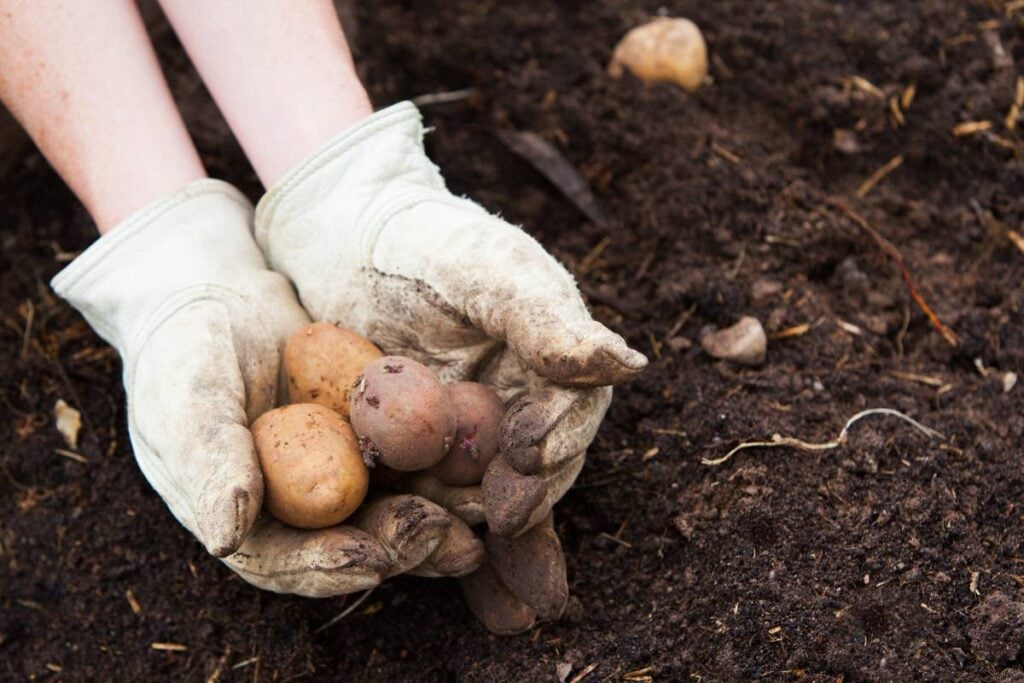
When purchasing potato seeds, you may find hundreds of kinds.
But only some potato seeds are suitable for plantation in raised garden beds.
You need to understand which potato variety will grow best in your raised garden bed, and you can find the right variety after researching.
Make sure you always buy seeds from a reputed dealer to ensure that the potatoes will be disease free.
The potato seeds come in three varieties: early season, mid-season, and late season.
Please study the chart below for detailed information about all three varieties.
| Early season potatoes | Mid-season potatoes | Late season potatoes |
|---|---|---|
| This potato variety has a short growing season and will fully mature within 75 to 90 days. | This potato variety will take 95 to 110 days to fully mature. | This potato variety has a long growing season and will take 135 days to attain maturity. |
| Yukon gold, Irish cobbler, and Norland are some early-season potatoes suitable for raised beds. | Catalina, red Pontiac, Yukon gem, gold rush, and French fingerling are some mid-season potatoes that grow well in a raised bed. | Purple Peruvian, Carola, butte, and German butterball are some late-season potatoes popularly grown in raised beds. |
What mistakes should you avoid while growing potatoes in a raised garden bed?
There are some common mistakes beginners make when it comes to growing potatoes, and these mistakes can severely reduce the yields.
Mistakes like Improper spacing, inadequate watering, or poor fertilization can put your growing efforts to waste.
However, you can easily overcome these errors with a little planning and research.
If you want to grow potato tubers in your raised bed garden successfully, avoid doing the following growing mistakes I have mentioned below.
1. When seeds didn’t sprout
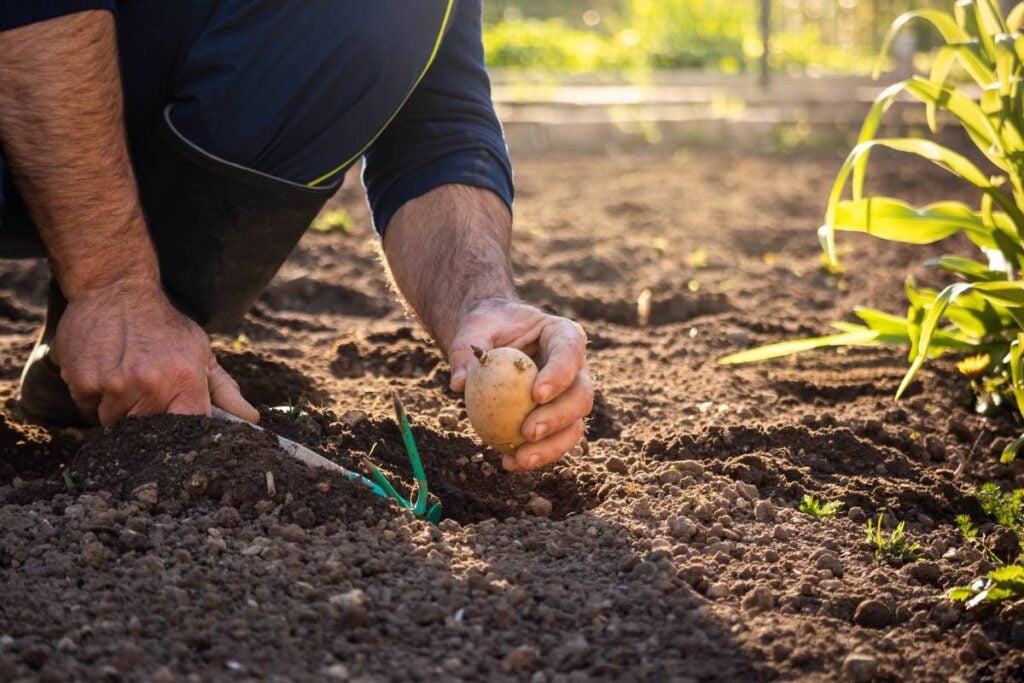
We often plant seeds in the raised bed that don’t sprout.
The seeds are exposed to certain conditions that don’t let them sprout.
You should be aware of these conditions and try to keep the seeds away from them.
How can I avoid this mistake?
Potatoes are hardy crops and don’t need extreme temperatures for sprouting.
A soil temperature of 45°C or greater is suitable for their plantation.
Also, avoid planting the seeds during the rainy season as moist conditions can rot them and won’t let them sprout.
2. Failing to fulfill basic necessities
All vegetable plants have their basic sunlight, soil, and water needs.
The potatoes will not grow if you keep them away from these needs.
How can I avoid this mistake?
You can avoid this mistake by planting your potato plant in full sun and well-draining soil.
Proper sunlight will help the plants to photosynthesize well, and using well-drained soil will drain the excess water easily and will not let the plant stay in a soggy state.
Also, water the plants with an inch of water every week during the growing season.
Always provide your potato plants with what they need for a healthy harvest.
3. Growing potatoes bought from grocery stores
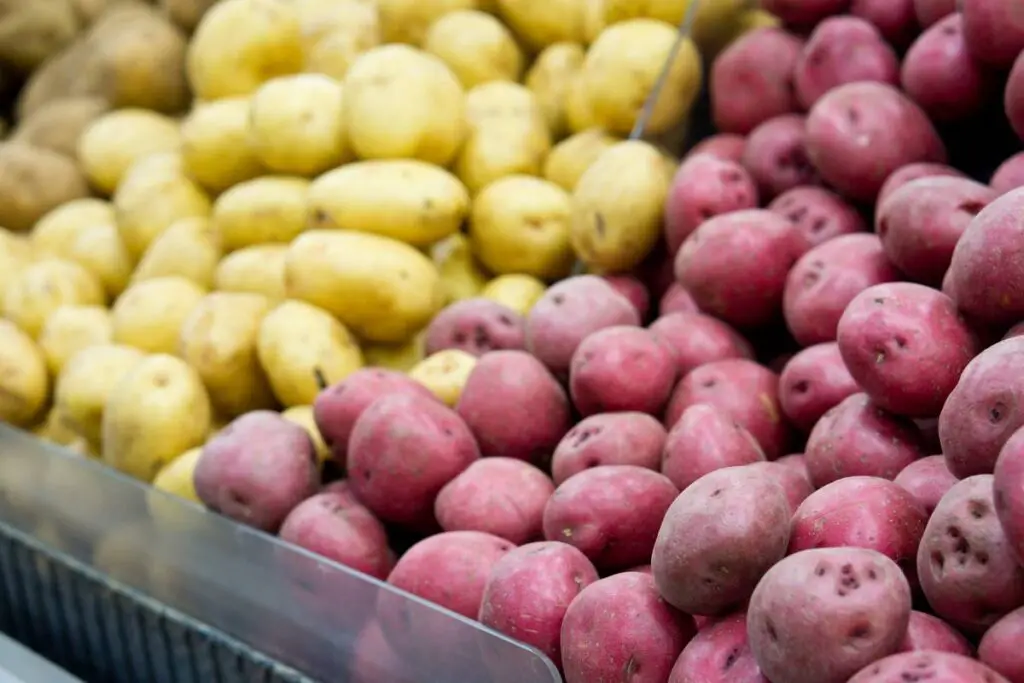
People new to gardening often buy potatoes from grocery stores and plant them, thinking they will receive a harvest.
It’s possible to grow potatoes this way; however, the success rate is very low.
Instead, purchasing seed potatoes from a reputed store is a better option for a plantation in a raised bed.
How can I avoid this mistake?
The potatoes sold in the grocery market are usually sprayed with a chemical to prevent them from sprouting.
That’s why they are not suitable for plantation.
Also, they might carry pests and diseases, and planting them will put your other plants in trouble.
Hence, it’s always better to choose seed potatoes as a safer option for raised bed gardening.
4. Not hilling the potatoes
When you plant potato seeds, hilling plays an important role.
Hilling is when you cover the plant’s base with soil to ensure that its stems are supported.
How can I avoid this mistake?
It would be best if you hilled the potato plants weekly and more frequently depending on their growth.
During the hilling process, leave the plant’s 2 to 3 leaves exposed for performing growth functions.
5. Not taking steps to cure the cut potatoes
Many people don’t plant an entire seed potato; instead, they cut it into many small pieces.
As per the theory, any slice with an eye has the potential to grow into a new potato plant.
So, it is an effective way to get many potato plants without spending much money.
But many people cut the potatoes seeds early, plant them late, and get disappointed when they don’t get any results.
Cutting the seeds too early before the plantation will cause them to rot and die.
How can I avoid this mistake?
Cutting the potato seeds into slices to get more plants is not wrong; you can surely follow this method after taking precautions.
Ensure you cut the potatoes just before planting them in the soil and not earlier to prevent them from rotting.
6. Neglecting pests and diseases
Gardening is an enjoyable activity but a challenging task.
There are many plants in your raised garden bed; keeping an eye on them is not always possible.
You may overlook the pest and diseases, and these predators, in a very short time, will destroy your potato crops if left untreated.
How can I avoid this mistake?
Potatoes are vulnerable to pests and diseases, so it’s crucial to keep a check on them to avoid any such threats.
Pests like aphids, potato beetles, spider mites, and leaf hoppers are common threats to potato plants.
You can use an insecticide to treat the pests.
Regarding diseases, mosaic virus, black scarf, and black leg are severely dangerous to potato plants.
If your potato plants are disease infected, remove them from the raised bed to prevent the further spread of diseases.
After that, treat the healthy plants with a fungicide.
Improve the growing conditions around the plants to prevent such issues in the future.
7. Incorrectly spacing the potato tubers
Potato plants need ample space to grow and thrive under the soil.
When potatoes are planted too close together, they will not get the required space for forming tubers.
Close spacing will inhibit their production, and the potatoes obtained will be smaller than the usual size.
How can I avoid this mistake?
Encase if you have accidentally planted your potato plants closely, don’t get disheartened.
It is because you can still harvest the young potatoes when they begin to set on and eat them as baby potatoes.
Next time you plant potato seeds, follow the correct spacing measurements.
8. Harvesting the potatoes at the wrong time
It is a cherishing moment when we get the fruits of our labor.
So, one common mistake many people make out of excitement is that they harvest the potatoes early before the actual harvesting season.
Early harvest will lead to smaller potatoes with poor taste.
How can I avoid this mistake?
Avoid harvesting the potato plants until they turn yellow and die back. Once it happens, dig the potato out of the ground.
But if you notice that the potatoes are still green, they are still growing and not ready to get harvested.
Reference: ScienceDirect, American Society of Agronomy, Noble Research Institute, Soil for Raised Beds, Raised Bed Gardening, Potatoes in the raised garden beds.
